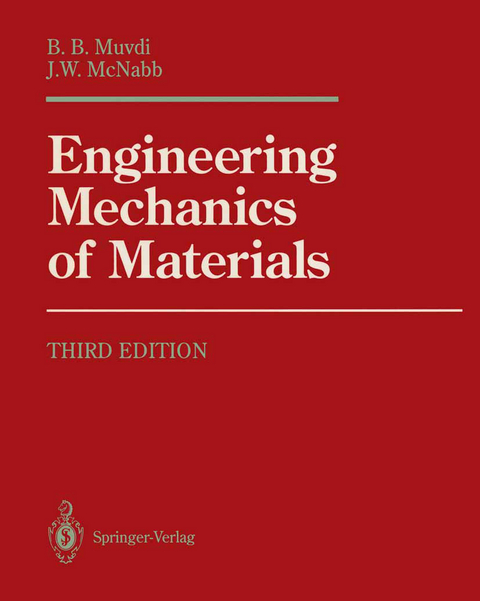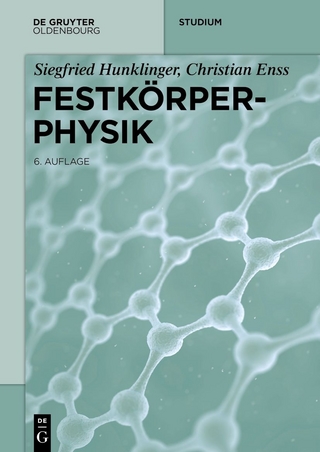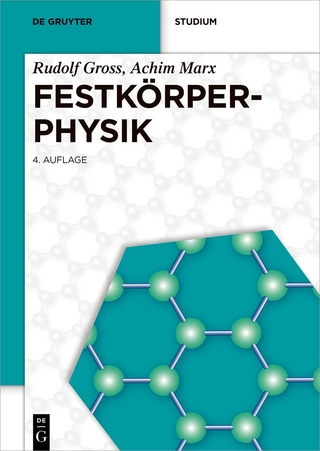
Engineering Mechanics of Materials
Springer-Verlag New York Inc.
978-1-4612-7764-4 (ISBN)
4. 2 Solid Circular Shafts-Angle of Twist and Shearing Stresses 159 4. 3 Hollow Circular Shafts-Angle of Twist and Shearing Stresses 166 4. 4 Principal Stresses and Strains Associated with Torsion 173 4. 5 Analytical and Experimental Solutions for Torsion of Members of Noncircular Cross Sections 179 4. 6 Shearing Stress-Strain Properties 188 *4. 7 Computer Applications 195 5 Stresses in Beams 198 5. 1 Introduction 198 5. 2 Review of Properties of Areas 198 5. 3 Flexural Stresses due to Symmetric Bending of Beams 211 5. 4 Shear Stresses in Symmetrically Loaded Beams 230 *5. 5 Flexural Stresses due to Unsymmetric Bending of Beams 248 *5. 6 Computer Applications 258 Deflections of Beams 265 I 6. 1 Introduction 265 6. 2 Moment-Curvature Relationship 266 6. 3 Beam Deflections-Two Successive Integrations 268 6. 4 Derivatives of the Elastic Curve Equation and Their Physical Significance 280 6. 5 Beam Deflections-The Method of Superposition 290 6. 6 Construction of Moment Diagrams by Cantilever Parts 299 6. 7 Beam Deflections-The Area-Moment Method 302 *6. 8 Beam Deflections-Singularity Functions 319 *6. 9 Beam Deflections-Castigliano's Second Theorem 324 *6. 10 Computer Applications 332 7 Combined Stresses and Theories of Failure 336 7. 1 Introduction 336 7. 2 Axial and Torsional Stresses 336 Axial and Flexural Stresses 342 7. 3 Torsional and Flexural Stresses 352 7. 4 7. 5 Torsional, Flexural, and Axial Stresses 358 *7. 6 Theories of Failure 365 Computer Applications 378 *7.
1 Internal Forces in Members.- 1.1 Introduction.- 1.2 Axially Loaded Members in Equilibrium.- 1.3 Variable Axial Loading—Internal Force Relationships.- 1.4 Torsionally Loaded Members in Equilibrium.- 1.5 Variable Torsional Loading—Torque Relationships.- 1.6 Shear and Bending Moment in Beams.- 1.7 Shear and Moment at Specified Sections.- 1.8 Shear and Moment Relationships.- 1.9 Combined Loadings and Associated Diagrams.- 1.10 Computer Applications.- 2 Stress, Strain, and Their Relationships.- 2.1 Introduction.- 2.2 Concept of Stress at a Point.- 2.3 Components of Stress.- 2.4 Analysis of Plane Stress.- 2.5 Mohr’s Circle for Plane Stress.- 2.6 The Absolute Maximum Shear Stress.- 2.7 Concept of Strain at a Point.- 2.8 Analysis of Plane Strain.- 2.9 Linear Stress-Strain Relations.- 2.10 Computer Applications.- 3 Stresses and Strains in Axially Loaded Members.- 3.1 Introduction.- 3.2 Stresses due to Axial Forces.- 3.3 Strain and Deformation due to Axial Forces.- 3.4 Mechanical Properties of Materials Under Axial Forces.- 3.5 Computer Applications.- 4 Torsional Stresses, Strains, and Rotations.- 4.1 Introduction.- 4.2 Solid Circular Shafts—Angle of Twist and Shearing Stresses.- 4.3 Hollow Circular Shafts—Angle of Twist and Shearing Stresses.- 4.4 Principal Stresses and Strains Associated with Torsion.- 4.5 Analytical and Experimental Solutions for Torsion of Members of Noncircular Cross Sections.- 4.6 Shearing Stress-Strain Properties.- 4.7 Computer Applications.- 5 Stresses in Beams.- 5.1 Introduction.- 5.2 Review of Properties of Areas.- 5.3 Flexural Stresses due to Symmetric Bending of Beams.- 5.4 Shear Stresses in Symmetrically Loaded Beams.- 5.5 Flexural Stresses due to Unsymmetric Bending of Beams.- 5.6 Computer Applications.- 6 Deflections of Beams.- 6.1Introduction.- 6.2 Moment-Curvature Relationship.- 6.3 Beam Deflections—Two Successive Integrations.- 6.4 Derivatives of the Elastic Curve Equation and Their Physical Significance.- 6.5 Beam Deflections—The Method of Superposition.- 6.6 Construction of Moment Diagrams by Cantilever Parts.- 6.7 Beam Deflections—The Area-Moment Method.- 6.8 Beam Deflections—Singularity Functions.- 6.9 Beam Deflections—Castigliano’s Second Theorem.- 6.10 Computer Applications.- 7 Combined Stresses and Theories of Failure.- 7.1 Introduction.- 7.2 Axial and Torsional Stresses.- 7.3 Axial and Flexural Stresses.- 7.4 Torsional and Flexural Stresses.- 7.5 Torsional, Flexural, and Axial Stresses.- 7.6 Theories of Failure.- 7.7 Computer Applications.- 8 Column Theory and Analyses.- 8.1 Introduction.- 8.2 Stability of Equilibrium.- 8.3 Ideal Column Theory—The Euler Critical Load.- 8.4 Effect of End Conditions on Behavior of Columns.- 8.5 Eccentrically Loaded and Initially Curved Columns.- 8.6 Empirical Equations for Column Allowable Loads.- 8.7 Computer Applications.- 9 Statically Indeterminate Members.- 9.1 Introduction.- 9.2 Effects of Temperature Changes.- 9.3 Statically Indeterminate Members Under Axial Loads.- 9.4 Statically Indeterminate Members Under Torsional Loads.- 9.5 Statically Indeterminate Members Under Flexural Loads—Two Successive Integrations.- 9.6 Statically Indeterminate Members Under Flexural Loads—Superposition.- 9.7 Statically Indeterminate Members Under Flexural Loads—Area Moment.- 9.8 Statically Indeterminate Members Under Flexural Loads—Castigliano’s Second Theorem.- 9.9 Computer Applications.- 10 Introduction to Component Design.- 10.1 Introduction.- 10.2 Basic Concepts of Design.- 10.3 Design of Axially Loaded Members.- 10.4 Design of TorsionalMembers.- 10.5 Design of Flexural Members.- 10.6 Design of Columns.- 10.7 Computer Applications.- 11 Analysis and Design for Inelastic Behavior.- 11.1 Introduction.- 11.2 Inelastic Behavior of Torsional Members.- 11.3 Inelastic Behavior of Bending Members.- 11.4 The Plastic Hinge Concept.- 11.5 Pseudo-Mechanism Formation and Moment Redistribution for Beams.- 11.6 Design for Inelastic Behavior of Torsional and Bending Members.- 11.7 Computer Applications.- 12 Analysis and Design for Impact and Fatigue Loadings.- 12.1 Introduction.- 12.2 Stress Concentrations.- 12.3 Axial, Torsional, and Bending Impact Analyses.- 12.4 Fatigue Loadings—Analysis and Design.- 12.5 Computer Applications.- 13 Selected Topics.- 13.1 Introduction.- 13.2 Thin-Walled Pressure Vessels.- 13.3 Thick-Walled Cylindrical Pressure Vessels.- 13.4 Shear Center for Thin-Walled, Open Cross Sections.- 13.5 Beams of Two Materials.- 13.6 Reinforced Concrete Beams—Elastic Method.- 13.7 Circumferential Stresses in Curved Beams.- 13.8 Computer Applications Using the STRESS Language.- APPENDIX A Computer Programming for Mechanics of Materials.- B Reactions at Connections and Supports.- C Physical and Mechanical Properties of Selected Materials.- D Properties of Plane Areas.- E Design Properties for Selected Structural Sections.- F Plastic Design Properties for Selected Structural Sections.- G SI Units.- H Selected References.- Answers to Even-Numbered Problems.
| Zusatzinfo | X, 693 p. |
|---|---|
| Verlagsort | New York, NY |
| Sprache | englisch |
| Maße | 203 x 254 mm |
| Themenwelt | Naturwissenschaften ► Physik / Astronomie ► Festkörperphysik |
| Naturwissenschaften ► Physik / Astronomie ► Mechanik | |
| Naturwissenschaften ► Physik / Astronomie ► Thermodynamik | |
| Technik ► Bauwesen | |
| Technik ► Maschinenbau | |
| ISBN-10 | 1-4612-7764-7 / 1461277647 |
| ISBN-13 | 978-1-4612-7764-4 / 9781461277644 |
| Zustand | Neuware |
| Haben Sie eine Frage zum Produkt? |
aus dem Bereich


